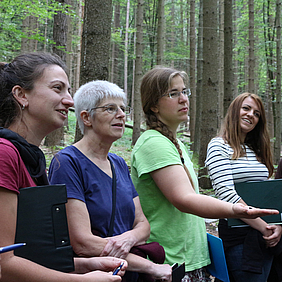Interpret Europe seeks to serve those who give natural and cultural heritage a deeper meaning. One key approach to achieving this is IE’s recently launched training programme.
Heritage interpretation in Europe is a toddler. Its family and friends certainly know it well; they are aware of its strengths, but can also discern its weaknesses. It’s growing fast, but still a long way from having a solid reputation of its own and hasn’t yet been introduced to a wider circle of people.
Over the last 12 months, Interpret Europe has been developing its own training programme that incorporates its mission: ‘To serve all who use first-hand experiences to give natural and cultural heritage a deeper meaning’.
Through this training programme, IE will offer to interpretive professionals across Europe the practical tools they need. A range of courses will focus on different aspects of heritage interpretation, such as interpretive guiding, writing, planning and live interpretation. Each of those subjects has (or will have) its own curriculum and a number of certified trainers from all over Europe.
In IE, training for trainers is based on first-hand experience. Every trainer-to-be must first experience a course as a trainee to grasp its qualities before being able to reproduce them. This way, we can ensure that all IE certified trainers embody the qualities they are representing.
The dual nature of this role was the core of IE’s first trainer course, this August in Brno. Fifteen participants from different countries, with training and interpretive backgrounds, took part in our guide course. They experienced all exercises from the participants’ perspective and thus discovered its secrets before being certified as trainers. Extra, during-the-course sessions, gave participants the opportunity to reflect on each activity in the course, the methods used, and the competences gained.
This method of training-the-trainers may be complex and is certainly more challenging for the training team, but it gradually creates a strong network of certified trainers, able to run IE courses in their own countries, in their own languages, thus ensuring that heritage interpretation quality standards will be respected and disseminated.
So, as you can see, Interpret Europe has been busy over the last year putting the building blocks in place so that it will help heritage interpretation grow from being a toddler to becoming a recognised and respected part of the European reality.
Valya Stergioti works as a freelance interpretive trainer and planner and is the Training Coordinator of Interpret Europe. You can contact Valya at valya.stergioti@interpret-europe.net.
To cite this article:
Stergioti, V. (2016) ‘IE’s training programme: behind the scenes’. In Interpret Europe Newsletter 3-2016, 4
Available online:
https://www.interpret-europe.net/fileadmin/Documents/publications/Newsletters/ie-newsletter_2016-3_autumn.pdf




